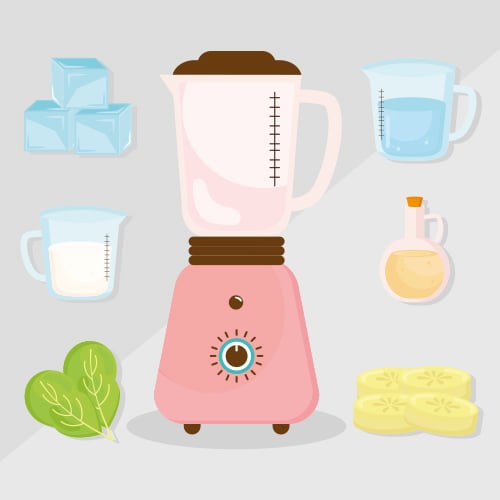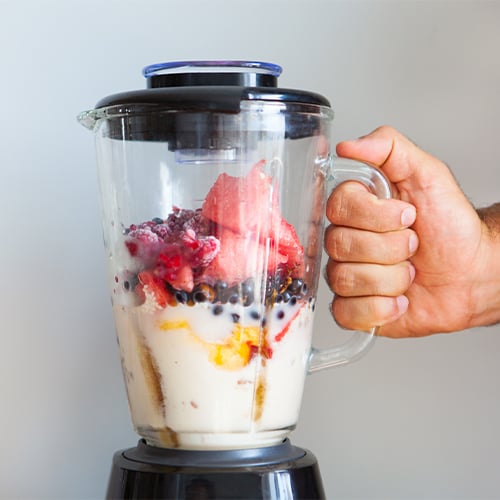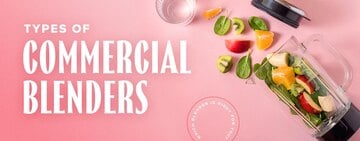Did you know your smoothies and blended drinks will have a better texture if you layer your ingredients properly? The right order of ingredients in the blender jar can improve your drinks and help to extend the life of your blender. If you own a smoothie shop or you work with blended drinks frequently, these tips will help you serve guests more efficiently. We'll explain proper blender layering below!
Smoothie Ingredient Order
Check out our video for a quick tutorial on smoothie layering. We'll show you the best order of ingredients:
How to Layer a Smoothie the Right Way
If you find that your blender isn't blending your drinks to a smooth, creamy consistency, the issue may be with your layering technique. High-powered commercial food and beverage blenders are designed to handle tough ingredients and ice, but sometimes they need a little help. Adding the ingredients in the right order may be enough to fix your blender issues. If you are experiencing other problems, check out our blender troubleshooting guide.

1. Liquids
Whether you're using water, milk, or juice, always add the liquid ingredients to the blender jar first. This helps the blender blades move more easily through the rest of your ingredients. Plus, many blender jars are designed with gradation marks, so you can measure the amount of liquid you are adding without dirtying a measuring cup.
2. Dry Ingredients
Next, add any dry ingredients like protein powders, cocoa powder, and sweeteners. Adding the dry ingredients right after the liquid can help prevent clumping and ensure a smoother blend. When dry ingredients are added first, they can often stick to the bottom of the blender jar, making it difficult for the blades to properly incorporate them into the mixture. If you add powders last, the blending process will take much longer and require more tamping. By adding dry ingredients directly after the liquid, you give the blender a better chance to evenly distribute the powders throughout the smoothie.
3. Leafy Greens
If you're adding leafy greens to the smoothie to boost its nutritional value, we recommend doing this as the third step. This ensures that the greens are evenly incorporated and no stringy fibers are left behind. Types of greens like spinach, kale, and swiss chard make a great addition to smoothies, and their flavor is undetectable once they have been blended into the other ingredients.
4. Soft Ingredients
Soft ingredients like tofu, yogurt, or nut butter should be added next. The texture of these ingredients makes them easier to blend compared to frozen fruits or ice. By placing them as the fourth layer, you ensure that they get thoroughly mixed with the rest of the ingredients, resulting in a smooth and consistent texture throughout your smoothie.
5. Fresh Fruit

The fifth layer of smoothie ingredients should be fresh fruits or veggies. Make sure to cut these up into manageable pieces so they blend more evenly. Save any frozen fruit or veggies for the last step!
6. Nuts and Seeds
When using nuts or seeds in a smoothie, they should be added second to last. The liquids and soft ingredients in the bottom of the blender jar provide a smooth base for the blades to move through, ensuring that the hard nuts and seeds are pulverized completely.
7. Ice and Frozen Fruits
It's finally time to add the ice! It's a common misconception that ice and frozen fruit should be added to the jar first, but this just makes the blender blades work much harder. Commercial blender blades can chop through ice with no problem, but you can prevent overworking the blender by adding the frozen ingredients last. They will help push the other ingredients down into the blades, and you'll get more consistent results. When it comes to frozen fruit, which can be tougher to blend than ice cubes, we recommend partially thawing the fruit first.
Blender Layering Guide
Check out our layering guide for a visual reference while blending your smoothies:
Different ingredients have different textures, and blending them in a specific order can help create a smooth and creamy consistency. The blend time will be quicker and you won't have to stop your machine to stir or tamp down the ingredients. This will save you precious minutes while you're preparing customer orders and help to produce a better-tasting product. You'll also help to extend the life of your blender and avoid replacing your blades or other components.




